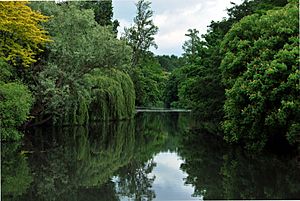Syon Park facts for kids
| Site of Special Scientific Interest | |

Lake at Syon Park
|
|
| Area of Search | Greater London |
|---|---|
| Interest | Biological |
| Area | 21.5 hectares |
| Notification | 1984 |
| Location map | Magic Map |
Syon Park is a large and beautiful garden in Isleworth, London. It is the home of the Duke of Northumberland. The park covers about 56.6 hectares (139 acres) and is a very important place for nature.
A famous landscape designer named Capability Brown helped design the gardens in the 1700s. Because of its special history, English Heritage has given it a Grade I listing. Parts of Syon Park are also protected as a Site of Special Scientific Interest (SSSI) and a Site of Metropolitan Importance for Nature Conservation. This means it is a really important place for wildlife.
Contents
History of Syon Park
Syon Park has a long and interesting past. It was once the site of a place called Syon Abbey. This abbey was founded in 1415 and was named after Mount Zion in Jerusalem. The abbey was closed down in 1539. In 2003, people found parts of the old abbey's foundations.
When the gardens were designed in the mid-1700s, many rare trees and plants were added. A large lake was also created. Today, this lake is home to many terrapins.
The Great Conservatory
One of the most impressive buildings in Syon Park is the Great Conservatory. It was built in 1826. The design was created by Charles Fowler. This building was special because it was the first large conservatory ever built using cast iron.
Wildlife in the Flood Meadows
Next to the River Thames in Syon Park, there is a special area called the Tide Meadow. This part of the park is 21.5 hectares (about 53 acres) and is a protected Site of Special Scientific Interest (SSSI).
Plants and Animals in the Meadow
The Tide Meadow is a wet area with tall reed-grasses. In higher parts of the meadow, you can find rye-grass and meadow-grass. There are also many small ditches that crisscross the area.
This meadow is a fantastic home for wildlife. Many birds come here to spend the winter. It also has several rare types of invertebrates, which are small creatures without backbones. Some uncommon kinds of flies live here too.
Visiting Syon Park
You can visit Syon Park by going to Park Road. The park is open to visitors during the summer months. There is a charge to enter. The park closes during the winter.


